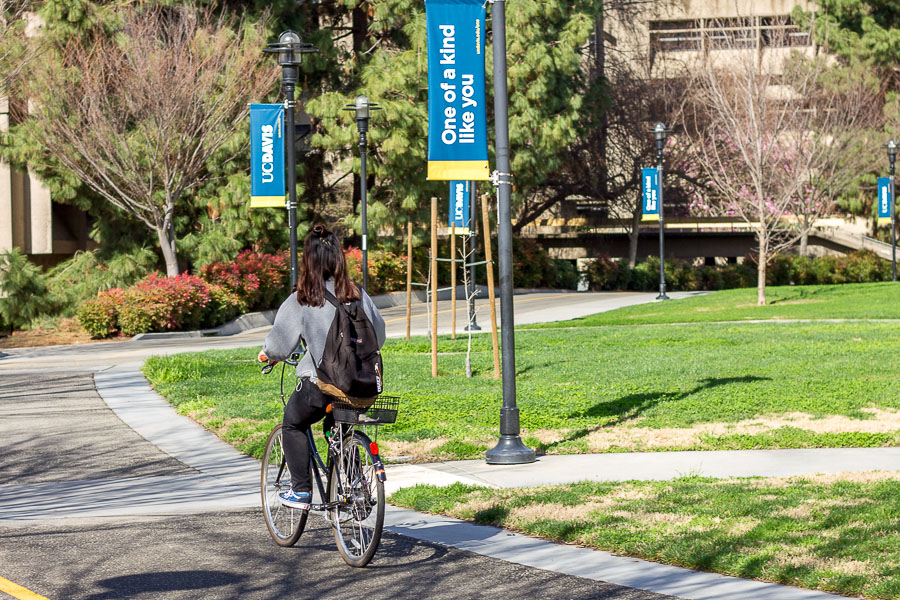
UC Davis leads in sustainability with largest solar power plant of any university
The University of California’s 13th Annual Report on Sustainable Practices was presented at the UC Board of Regents meeting on Jan. 25. The 2016 report relays both the UC’s successes and challenges ahead in regards to renewable energy, water conservation, waste reduction, food sustainability and UC-wide sustainability goals.
“We’re attacking this challenge on multiple fronts — undertaking basic and applied research, teaching, changing the way we operate, investing in climate change solutions and being a model of positive change,” said UC President Janet Napolitano in the report.
The report highlights UC Davis’ implementation of its 16.3 MW large solar power plant, the largest known on any university campus, which generates approximately 33 million kilowatt hours for the campus and reduces greenhouse gas emissions by about 14,000 metric tons annually.
UC Davis has been consistently meeting or approaching UC-wide sustainability goals. The campus achieved the 2014 policy goal of reducing greenhouse gas emissions to 2000 levels, diverted 73 percent of its waste from the landfill and reduced growth-adjusted potable water consumption by 36 percent from the 2020 baseline, thereby achieving the 2025 policy goal early.
Camille Kirk, assistant director of sustainability at UC Davis, cited additional instances in which UC Davis has been at the forefront of sustainability.
“UC Davis continues to demonstrate leadership in sustainability, through efforts like […] investing in our pathways and bikeways to enable sustainable transportation and achieving a 27 percent reduction in water use at the Davis campus over the past year,” Kirk said via email.
Llyod Knox, a physics professor at UC Davis, also believes that UC Davis is at the forefront of increased sustainability.
“Student activism initially stirred the university conversation about reducing our carbon emissions all the way to zero,” Knox said via email. “In 2013 Janet Napolitano declared we would do it by 2025. UC Davis is a leader in the system on this front, doing more to realize this goal than any of the other campuses.”
A program launched systemwide in 2016 aims to give students the tools to face global climate change. In the summer of 2016, faculty across the UC system attended workshops to develop new material incorporating climate change and sustainability into existing courses.
“Preparing our students to be leaders in the areas of climate change and environmental sustainability is no longer an option; it is an imperative,” Napolitano said in the report.
UC Davis offers many classes on sustainability, climate science and research on environmental and sustainability questions. Students also voted in 2016 to establish the Green Initiative Fund, which supports sustainability projects and student internships.
“Here at UC Davis we view the university as a living laboratory, where we are finding and implementing solutions that will be adopted elsewhere,” Knox said via email. “Students can get involved, contribute and learn useful skills, through project-based courses.”
Two interdisciplinary courses, A Path to Zero Net Energy: A Hands-on Approach (ABT 289A) and Pathways to Climate Neutrality in California (PHY150), are open to non-science majors. In both classes, students can work in small teams on real-world carbon emission reduction projects.
ABT 289A will be taught by biological and agricultural engineering professor Kurt Kornbluth in the spring of 2017 and PHY150 will be taught by physics professor Lloyd Knox in the fall of 2017.
UC Santa Barbara, UCLA and UC Berkeley have already surpassed the 1990 greenhouse gas emissions level, which they were supposed to stay under until 2020.
In order to reach the 2025 goal UCs will need to reduce emissions by over 1 million metric tons of CO2. This would equate to taking approximately 850,000 passenger vehicles off the road for one year. Unfortunately, current efforts are not enough to reach carbon neutrality systemwide by 2025.
More information regarding the 2016 Annual Report on Sustainability can be found on its website. Interested individuals can also look at a sustainability map of UC Davis.
Written by: Yvonne Leong — campus@theaggie.org



